Abstract
This paper constructs the generalized viscosity implicit midpoint rule for nonexpansive mappings in Banach space. It obtains strong convergence conclusions for the proposed algorithm and promotes the related results in this field. Moreover, this paper gives some applications. Finally, the paper gives six numerical examples to support the main results.
1. Introduction
Let be a Banach Space and the dual space. denotes the normalized duality mapping from to and is defined by
It is well known that if is a Hilbert space, then is the identity mapping; if is a smooth Banach space, then is single-valued and denoted by . More information on the normalized duality mapping can be found, for example, in [,].
Let be a nonempty set of . Mapping of is contractive if , , and . Mapping of is nonexpansive if and . Let denote the fixed point set of . More information on nonexpansive mappings and their fixed points can be found, for example, in [].
The implicit midpoint rule can effectively solve ordinary differential equations (see [,,,,,] and the references therein). Meanwhile, many authors have used viscosity iterative algorithms for finding common fixed points for nonlinear operators and solutions of variational inequality problems (see [,,,,,,,] and the references therein).
In 2004, Xu [] proposed the explicit viscosity method for nonexpansive mappings in Hilbert space or uniformly smooth Banach space:
was generated by the above iterative algorithm and strongly converged to , where was the solution of variational inequality and .
In 2015, Xu et al. [] constructed the viscosity implicit midpoint rule for nonexpansive mapping in Hilbert space:
was generated by the above. Under many conditions of , strongly converged to , where was the solution of variational inequality and .
In 2015, Ke et al. [] improved the results of Xu et al. [] from the viscosity implicit midpoint rule to generalized viscosity implicit rules for nonexpansive mappings in Hilbert spaces:
and
Under some conditions of , they proved that generated by (1) and (2) all strongly converged to , where was the solution of variational inequality and .
In 2017, Luo et al. [] generalized the conclusions of Xu et al. [] from Hilbert space to uniformly smooth Banach space:
was generated by the above. Under many conditions, strongly converged to , where was the solution of variational inequality and .
Motivated and inspired by Xu et al. [], Ke et al. [], and Luo et al. [], this paper proposes the generalized viscosity implicit rules for nonexpansive mappings in Banach space and proves strong convergence results. Next, this paper applies the results to a general system of variational inequality problems in Banach space and fixed-point problems of strict pseudocontractive mappings. Finally, this paper gives numerical examples to support the main results.
2. Preliminaries
Let be a Banach space. A mapping is defined by
where is the modulus of smoothness of . is uniformly smooth if . For example, is uniformly smooth Banach space. is q-uniformly smooth if such that .
We needed the following lemmas to prove our main results.
Lemma 1.
([,]) Assume is a sequence of non-negative real numbers such that
where is a sequence in and is a sequence in such that
Then, .
Lemma 2.
([,]) Let be a uniformly smooth Banach space, be a closed convex subset of , be a nonexpansive mapping with , and be a contractive mapping. Then the sequence defined by converges strongly to a point in . If we define a mapping by , where is the set of contractive mapping from to itself, then solves the following variational inequality:
Lemma 3.
([]) Let be a nonempty, closed convex subset of a real Banach space , which has a uniformly differentiable norm, and be a nonexpansive mapping with . Assume that strongly converges to a fixed point of as , where is defined by . Suppose is bounded and . Then .
3. Main Results
Theorem 1.
Let be a uniformly smooth Banach space, be a closed convex subset of , be a contractive mapping with , and be a nonexpansive mapping with . is generated by the generalized viscosity implicit midpoint rule
where and satisfies the conditions:
- (i)
- ;
- (ii)
- ;
- (iii)
- or ;
- (iv)
- , .
Then converges strongly to , which is also the unique solution of the variational inequality , and .
Proof.
The proof is split into five steps.
Step 1: Show that is bounded.
Take , then we have
It follows that
Then we get . By induction, we get
So, is bounded. Then and are also bounded.
Step 2: Show that .
By (3), we have
where .
It follows that
From , we have and . Then we get
From , , and Lemma 1, we get .
Step 3: Show that .
From and Step 2, we get .
Step 4: Show that .
Let be defined by . Then, from Lemma 2, converges strongly to , which is also the unique solution of the variational inequality , . From Steps 1–3 and Lemma 3, we get .
Step 5: Show that .
It follows that
Because
so, from , Step 4, and Lemma 1, we get . This completes the proof. □
It is well known that Hilbert space is uniformly smooth Banach space. So, we can get the main results of [].
Corollary 1.
([]) Let be a nonempty, closed convex subset of the real Hilbert space . Let be a nonexpansive mapping with and be a contraction with coefficient . Pick any and let be a sequence generated by
where that satisfies the following conditions:
- (1)
- ;
- (2)
- ;
- (3)
- ;
- (4)
- , .
Then converges strongly to a fixed point of the nonexpansive mapping , which is also the unique solution of the variational inequality , .
If we let , we can get the main results of [].
Corollary 2.
([]) Let be a closed convex subset of a uniformly smooth Banach space . Let be a nonexpansive mapping with , and a contraction with coefficient . Let be a sequence generated by the following viscosity implicit midpoint rule:
where is a sequence in such that:
- (i)
- ;
- (ii)
- ;
- (iii)
- either or .
Then converges strongly to a fixed point of , which also solves the following variational inequality: , .
Theorem 2.
Let be a uniformly smooth Banach space, be a closed convex subset of , be a contractive mapping with and be a nonexpansive mapping with . is generated by the generalized viscosity implicit midpoint rule
where and satisfies the conditions:
- (i)
- ;
- (ii)
- ;
- (iii)
- and ;
- (iv)
- , ;
- (v)
- and .
Then converges strongly to , which is also the unique solution of the variational inequality , and .
Proof.
The proof is split into five steps.
Step 1: Show that is bounded.
Take , then we have
It follows that
From , we have
So, is bounded. Then and are also bounded.
Step 2: Show that .
By (4), we have
where .
It follows that
From , we have and . Then we get
From , , , , and Lemma 1 we get .
Step 3: Show that .
From , and Step 2, we get .
Step 4: Show that .
Let be defined by . Then, from Lemma 2, converges strongly to , which is also the unique solution of the variational inequality and . From Steps 1–3 and Lemma 3, we get .
We have
It follows that . From Step 3, we get .
Step 5: Show that .
It follows that
where
Because
so from , , Step 4, and Lemma 1, we get . This completes the proof. □
If , we can get Theorem 1. So, Theorem 2 is a generalization of Theorem 1. And, the computational efficiency of Theorem 2 is better than Theorem 1.
It is well known that Hilbert space is uniformly smooth Banach space. So, we can get the main results of [].
Corollary 3.
([]) Let be a nonempty, closed convex subset of the real Hilbert space . Let be a nonexpansive mapping with and be a contraction with coefficient . Pick any and let be a sequence generated by
where that satisfies the following conditions:
- (1)
- ;
- (2)
- ;
- (3)
- and ;
- (4)
- , .
Then converges strongly to a fixed point of the nonexpansive mapping , which is also the unique solution of the variational inequality and .
If we let and , we can also get the main results of []. The results of Theorem 2 generalize the relevant results of [].
Corollary 4.
([]) Let be a uniformly smooth Banach space and a nonempty closed convex subset of . Let be a nonexpansive mapping with and a generalized contraction mapping. Pick any . Let be a sequence generated by
where , and are three sequences in satisfying the following conditions:
- (i)
- ;
- (ii)
- ;
- (iii)
- and ;
- (iv)
- for all .
Then converges strongly to a fixed point of the nonexpansive mapping , which is also the solution of the variational inequality for all .
4. Applications
(1) A fixed point problem for strict pseudocontractive mapping.
If there exists such that
then is called -strict pseudocontractive mapping.
Zhou [] obtained the relationship between nonexpansive mapping and -strict pseudocontractive mapping.
Lemma 4.
([]) Let be a nonempty, closed convex subset of a real 2-uniformly smooth Banach space and be a -strict pseudocontractive mapping. For , we define . Then, , where is the 2-uniformly smooth constant. Then, is nonexpansive such that .
So is nonexpansive, and then we can get the following results.
Theorem 3.
Let be a 2-uniformly smooth Banach space, be a closed convex subset of , be a contractive mapping with , be a -strict pseudocontractive mapping, and be defined by with . is generated by the generalized viscosity implicit midpoint rule
where and satisfies the conditions:
- (i)
- ;
- (ii)
- ;
- (iii)
- or ;
- (iv)
- , .
Then converges strongly to , which is also the unique solution of the variational inequality , and .
Theorem 4.
Let be a 2-uniformly smooth Banach space, be a closed convex subset of , be a contractive mapping with , be a -strict pseudocontractive mapping, and be defined by with . is generated by the generalized viscosity implicit midpoint rule
where and satisfies the conditions:
- (i)
- ;
- (ii)
- ;
- (iii)
- and ;
- (iv)
- , ;
- (v)
- and .
Then converges strongly to , which is also the unique solution of the variational inequality , and .
(2) A general system of a variational inequality problem in Banach space.
The problem of finding such that
is called the general system of variational inequalities in Banach space, where and are two nonlinear mappings.
If there exists satisfying , then is called accretive. If there exists and satisfying , then is called -inverse-strongly accretive.
Lemma 5.
([]) Let be a nonempty, closed convex subset of a real 2-uniformly smooth Banach space . Let be the sunny, nonexpansive retraction from onto . Let be -inverse-strongly accretive and -inverse-strongly accretive, respectively. Let be a mapping defined by , . If and , then is nonexpansive.
Thus, is nonexpansive, and we can get the following results. More information on nonexpansive retracts and retractions can be found in [,].
Theorem 5.
Let be a 2-uniformly smooth Banach space, be a closed convex subset of , be, respectively, -inverse-strongly accretive and -inverse-strongly accretive, be a contractive mapping with , and be defined by Lemma 5. is generated by the generalized viscosity implicit midpoint rule
where and satisfies the conditions:
- (i)
- ;
- (ii)
- ;
- (iii)
- or ;
- (iv)
- , .
Then converges strongly to , which is also the unique solution of the variational inequality , and .
Theorem 6.
Let be a 2-uniformly smooth Banach space, be a closed convex subset of , be, respectively, -inverse-strongly accretive and -inverse-strongly accretive, be a contractive mapping with , and be defined by Lemma 5. is generated by the generalized viscosity implicit midpoint rule
where and satisfies the conditions:
- (i)
- ;
- (ii)
- ;
- (iii)
- and ;
- (iv)
- , ;
- (v)
- and .
Then converges strongly to , which is also the unique solution of the variational inequality , and .
5. Numerical Examples
We give six numerical examples to support the main results.
Example 1.
Let be the real line with Euclidean norm, be defined by , be defined by , , and . So, . is generated by (3). From Theorem 1, converges strongly to 0.
Next, we simplify the form of (3) and get
Next, we take into (9). Finally, we get the following numerical results in Figure 1.
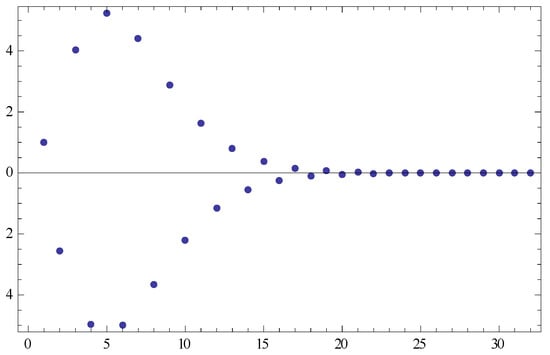
Figure 1.
Numerical results.
Example 2.
Let be the real line with Euclidean norm, be defined by , be defined by , , , , , and . So, . is generated by (4). From Theorem 2, converges strongly to 0.
Next, we simplify the form of (4) and get
Next, we take into (10). Finally, we get the following numerical results in Figure 2.
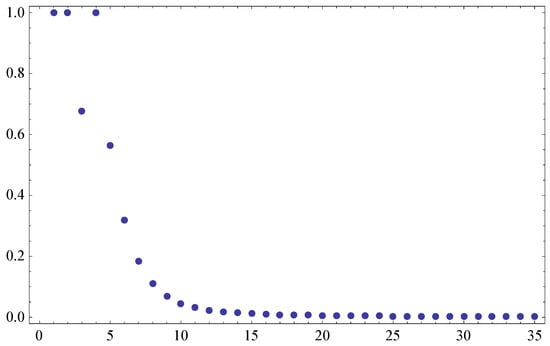
Figure 2.
Numerical results.
Example 3.
Let be the inner product and defined by
Let be the usual norm and defined by for any . For any , let be defined by and be defined by . So, . Let and , then they satisfy the conditions of Theorem 1. is generated by (3). From Theorem 1, converges strongly to 0.
Next, we simplify the form of (3) and get
Next, we take into (11). Finally, we get the following numerical results in Figure 3.
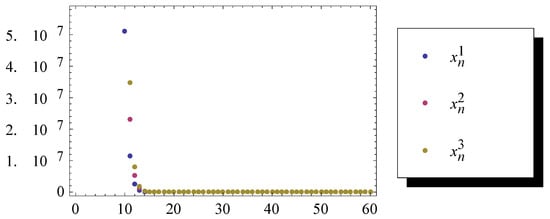
Figure 3.
Numerical results.
Example 4.
Let be the inner product and defined by
Let be the usual norm and defined by for any . For any , let be defined by and be defined by . So, . Let , and , then they satisfy the conditions of Theorem 2. is generated by (4). From Theorem 2, converges strongly to 0.
Next, we simplify the form of (4) and get
Next, we take into (12). Finally, we get the following numerical results in Figure 4.

Figure 4.
Numerical results.
Example 5.
Let be the real line with Euclidean norm, be defined by , be defined by , , and . So, . is generated by (3). From Theorem 1, converges strongly to 2.
Next, we simplify the form of (3) and get
Next, we take into (13). Finally, we get the following numerical results in Figure 5.
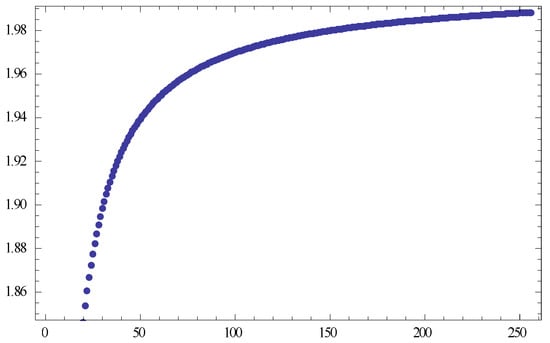
Figure 5.
Numerical results.
Example 6.
Let be the real line with Euclidean norm, be defined by , be defined by , , , , , and . So, . is generated by (4). From Theorem 2, converges strongly to 2.
Next, we simplify the form of (4) and get
Next, we take into (14). Finally, we get the following numerical results in Figure 6.
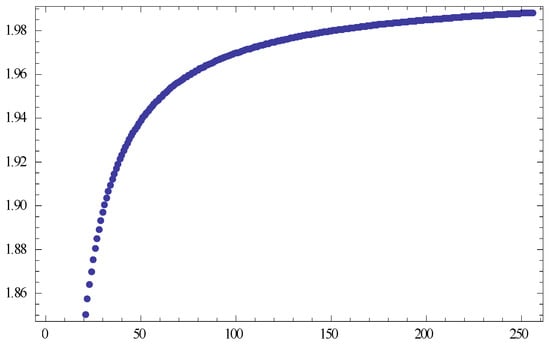
Figure 6.
Numerical results.
6. Conclusions
This paper proposes the generalized viscosity implicit rules for nonexpansive mappings in Banach space and concretely constructs two iterative algorithms:
This paper obtains strong convergence results. Results promote the work of Ke et al. [], Luo et al. [], and Yan et al. [] from Hilbert spaces to a general Banach spaces and their iterative algorithms and relevant conclusions. In the end, this paper gives six numerical examples to support the main results.
Author Contributions
The authors contributed equally to this paper.
Funding
This research was supported by the National Natural Science Foundation of Hebei Province (No. E2016209304).
Conflicts of Interest
No conflict of interest exists in the submission of this article, and it is approved by all authors for publication.
References
- Cioranescu, I. Geometry of Banach Spaces, Duality Mappings and Nonlinear Problems; Kluwer: Dordrecht, The Netherlands, 1990. [Google Scholar]
- Reich, S. Review of Geometry of Banach Spaces Duality Mappings and Nonlinear Problems by loana Cioranescu, Kluwer Academic Publishers, Dordrecht, 1990. Bull. Am. Math. Soc. 1992, 26, 367–370. [Google Scholar] [CrossRef]
- Goebel, K.; Reich, S. Uniform Convexity Hyperbolic Geometry and Nonexpansive Mappings; Marcel Dekker: New York, NY, USA, 1984. [Google Scholar]
- Auzinger, W.; Frank, R. Asymptotic error expansions for stiff equations: An analysis for the implicit midpoint and trapezoidal rules in the strongly stiff case. Numer. Math. 1989, 56, 469–499. [Google Scholar] [CrossRef]
- Bader, G.; Deuflhard, P. A semi-implicit mid-point rule for stiff systems of ordinary differential equations. Numer. Math. 1983, 41, 373–398. [Google Scholar] [CrossRef]
- Deuflhard, P. Recent progress in extrapolation methods for ordinary differential equations. SIAM Rev. 1985, 27, 505–535. [Google Scholar] [CrossRef]
- Schneider, C. Analysis of the linearly implicit mid-point rule for differential-algebra equations. Electron. Trans. Numer. Anal. 1993, 1, 1–10. [Google Scholar]
- Somalia, S. Implicit midpoint rule to the nonlinear degenerate boundary value problems. Int. J. Comput. Math. 2002, 79, 327–332. [Google Scholar] [CrossRef]
- Van Veldhuxzen, M. Asymptotic expansions of the global error for the implicit midpoint rule (stiff case). Computing 1984, 33, 185–192. [Google Scholar] [CrossRef]
- Xu, H.K. Viscosity approximation methods for nonexpansive mappings. J. Math. Anal. Appl. 2004, 298, 279–291. [Google Scholar] [CrossRef]
- Moudafi, A. Viscosity approximation methods for fixed points problems. J. Math. Anal. Appl. 2000, 241, 46–55. [Google Scholar] [CrossRef]
- Song, Y.; Chen, R.; Zhou, H. Viscosity approximation methods for nonexpansive mapping sequences in Banach spaces. Nonlinear Anal. 2007, 66, 1016–1024. [Google Scholar] [CrossRef]
- Jung, J.S. Iterative approaches to common fixed points of nonexpansive mappings in Banach spaces. J. Math. Anal. Appl. 2005, 302, 509–520. [Google Scholar] [CrossRef]
- Ceng, L.C.; Xu, H.K.; Yao, J.C. The viscosity approximation method for asymptotically nonexpansive mappings in Banach spaces. Nonlinear Anal. 2008, 69, 1402–1412. [Google Scholar] [CrossRef]
- Zegeye, H.; Shahzad, N. Viscosity methods of approximation for a common fixed point of a family of quasi-nonexpansive mappings. Nonlinear Anal. 2008, 68, 2005–2012. [Google Scholar] [CrossRef]
- Sunthrayuth, P.; Kumam, P. Viscosity approximation methods base on generalized contraction mappings for a countable family of strict pseudo-contractions, a general system of variational inequalities and a generalized mixed equilibrium problem in Banach spaces. Math. Comput. Model. 2013, 58, 1814–1828. [Google Scholar] [CrossRef]
- Kopecká, E.; Reich, S. Approximating fixed points in the Hilbert ball. J. Nonlinear Convex Anal. 2014, 15, 819–829. [Google Scholar]
- Xu, H.K.; Alghamdi, M.A.; Shahzad, N. The viscosity technique for the implicit midpoint rule of nonexpansive mappings in Hilbert spaces. Fixed Point Theory Appl. 2015, 2015, 41. [Google Scholar] [CrossRef]
- Ke, Y.F.; Ma, C.F. The generalized viscosity implicit rules of nonexpansive mappings in Hilbert spaces. Fixed Point Theory Appl. 2015, 2015, 190. [Google Scholar] [CrossRef]
- Luo, P.; Cai, G.; Shehu, Y. The viscosity iterative algorithms for the implicit midpoint rule of nonexpansive mappings in uniformly smooth Banach spaces. J. Inequal. Appl. 2017, 2017, 154. [Google Scholar] [CrossRef]
- Reich, S. Constructive techniques for accretive and monotone operators. In Applied Nonlinear Analysis; Academic Press: New York, NY, USA, 1979; pp. 335–345. [Google Scholar]
- Reich, S. Strong convergence theorems for resolvents of accretive operators in Banach spaces. J. Math. Anal. Appl. 1980, 75, 287–292. [Google Scholar] [CrossRef]
- Yan, Q.; Cai, G.; Luo, P. Strong convergence theorems for the generalized viscosity implicit rules of nonexpansive mappings in uniformly smooth Banach spaces. J. Nonlinear Sci. Appl. 2016, 9, 4039–4051. [Google Scholar] [CrossRef][Green Version]
- Zhou, H. Convergence theorems for λ-strict pseudo-contractions in 2-uniformly smooth Banach spaces. Nonlinear Anal. 2008, 69, 3160–3173. [Google Scholar] [CrossRef]
- Cai, G.; Bu, S. Convergence analysis for variational inequality problems and fixed point problems in 2-uniformly smooth and uniformly convex Banach spaces. Math. Comput. Model. 2012, 55, 538–546. [Google Scholar] [CrossRef]
- Reich, S. Asymptotic behavior of contractions in Banach spaces. J. Math. Anal. Appl. 1973, 44, 57–70. [Google Scholar] [CrossRef]
- Kopecká, E.; Reich, S. Nonexpansive retracts in Banach spaces. Banach Cent. Publ. 2007, 77, 161–174. [Google Scholar]
© 2019 by the authors. Licensee MDPI, Basel, Switzerland. This article is an open access article distributed under the terms and conditions of the Creative Commons Attribution (CC BY) license (http://creativecommons.org/licenses/by/4.0/).